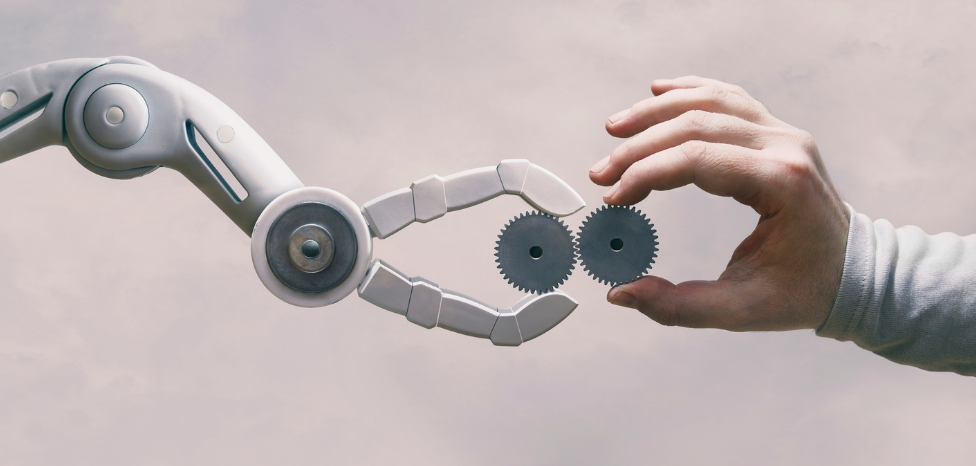In a world where humans perform tasks that involve manipulating objects, such as lifting, dragging or interacting with them (for example, when we use our beloved mobile phones or we eat an apple), these actions are performed subconsciously, naturally. It is our senses that allow us to adapt our physical characteristics to the tasks instinctively. In contrast, robots act like little human apprentices, imitating our behaviour, as they currently lack the same awareness and intelligence.
To address this gap, Human Robot Interaction (HRI) emerged, a discipline that seeks to understand, design and evaluate the interaction between robots and humans. This field had its beginnings in the 1990s with a multidisciplinary approach but today its study is in constantly evolving and has given rise to important events1 that bring together visionaries in the field, who seek to promote this technology, bringing us ever closer to a world where artifical intelligence and humans understand each other and collaborate,transforming our near future.
Understanding the discipline of human-robot interaction is crucial. It is not a simple task; rather, it is tremendously challenging, requiring contributions from cognitive science, linguistics, psychology, engineering, mathematics, computer science, and human factors design. As a result, multiple attributes are involved:
- Level of autonomy: decision making indepently
- Exchange of information: fluency and understanding between different parts.
- Different technologies and equipment: major adaptation between languages and models.
- Tasks configuration: definition and execution of tasks efficiently.
- Cognitive learning: abilities to learn and improve with time.
Here again, the type of interaction, is of particular importance, which is defined as a reciprocal action, relationship or influence between two or more persons, objects, agents, etc. and a key factor is the distance between human and robot, where it can be called a distance interaction, e.g. mobile robots that are sent into space, or a physical interaction, where the human being has contact with the robot.

Source: V. Villani, et al., Survey on human–robot collaboration in industrial settings: Safety, intuitive interfaces and applications, Mechatronics 55 (2018) 248–266,http://dx.doi.org/10.1016/j.mechatronics.2018.02.009
These attributes are just a sample of the complexities involved in these robotic interaction systems, where interdisciplinary collaboration is essential for their evolution.
The challenges of interaction between humans and robots
At the moment the challenges are related to the highly unstructured nature of the scenarios where collaborative robots are used, as it is impossible for a technology developer to structure the entire system environment. Among the most important challenges aspects related to mobility, communications, map constructions and situational awareness.
So, what is the next step in human-robot interaction? Challenges include getting them to speak the same language and improving and simplifying communication, especially for non-technologically trained people, not presupposing these prior skills and not needing complicated instruction manuals; also discovering new forms of interaction, through natural language, in the case of assistive robots, special care for proximity and vulnerability; in general improving interfaces, making them more agile and flexible, so that they can be easily adapted to different scenarios and changes in the environment.
On the other hand, a challenge that has become particularly important in recent times, is to take into account emotional needs, human values and ethics in human-robot interactions, as highlighted in this HRI definition above:
HRI definition (Human-Robot interaction)
is the science that studies people’s behaviour and attitudes towards robots in relation to their physical, technological and interactive characteristics, with the aim of developing robots that facilitate the emergence of efficient human-robot interactions (in accordance with the original requirements of their intended area of use), but are also acceptable to people and satisfy the social and emotional needs of their individual users, while respecting human values (Dautenhahn, 2013).
Inspired by this exciting field of work, CARTIF, in collaboration with FIWARE Foundation and other leading partners in Europe, will start in 2024 the European ARISE project, which aims to achieve real-time, agile, human-centric, open source technologies that drive solutions in Human-Robot HRI interaction by combining open technologies such as ROS 2, Vulcanexus and FIWARE. And where the aims is to solve challenges by funding experiments that develop agile HRI solutions with increasingly adaptive and intuitive interfaces.

ARISE will address many of the following challenges: (1) Application of collaborative robotics for disassembly of value-added products, (2) Picking of complex products in industrial warehouses, (3) Flexible robotic collaboration for more efficient assembly and quality control, (4) Intelligent reprogramming ensuring adaptability for different products through intuitive interfaces, (5) Search and transport tasks in healthcare environments, (6) Improving multimodal interaction around different functional tasks, (7) Robotic assistance in flexible high-precision tasks, and (8) Improving ergonomics and worker efficiency, thus generating a multidisciplinary framework that takes into account both technological and social aspects.
In addition, the ARISE project opens its doors to robotics experts so that they can collaborate in solving the various challenges, thus generating new technological components for the HRI Toolbox, such as ROS4HRI. This collaborative grand challenge aims to make it easier for companies to create agile and sustainable HRI aplications in the near future.
1 ACM/IEEE International Conference on Human-Robot Interaction, IEEE International Conference on Robotics and Automation (ICRA) y Robotics Systems and sciences
- Interoperability in Industry 5.0: the Key Role of FIWARE - 21 March 2025
- The evolution of HRIs (Human-robot interaction). More agile and adaptable to different scenarios - 5 December 2023
- Elicitation of knowledge: learning of expert operators - 3 February 2023
